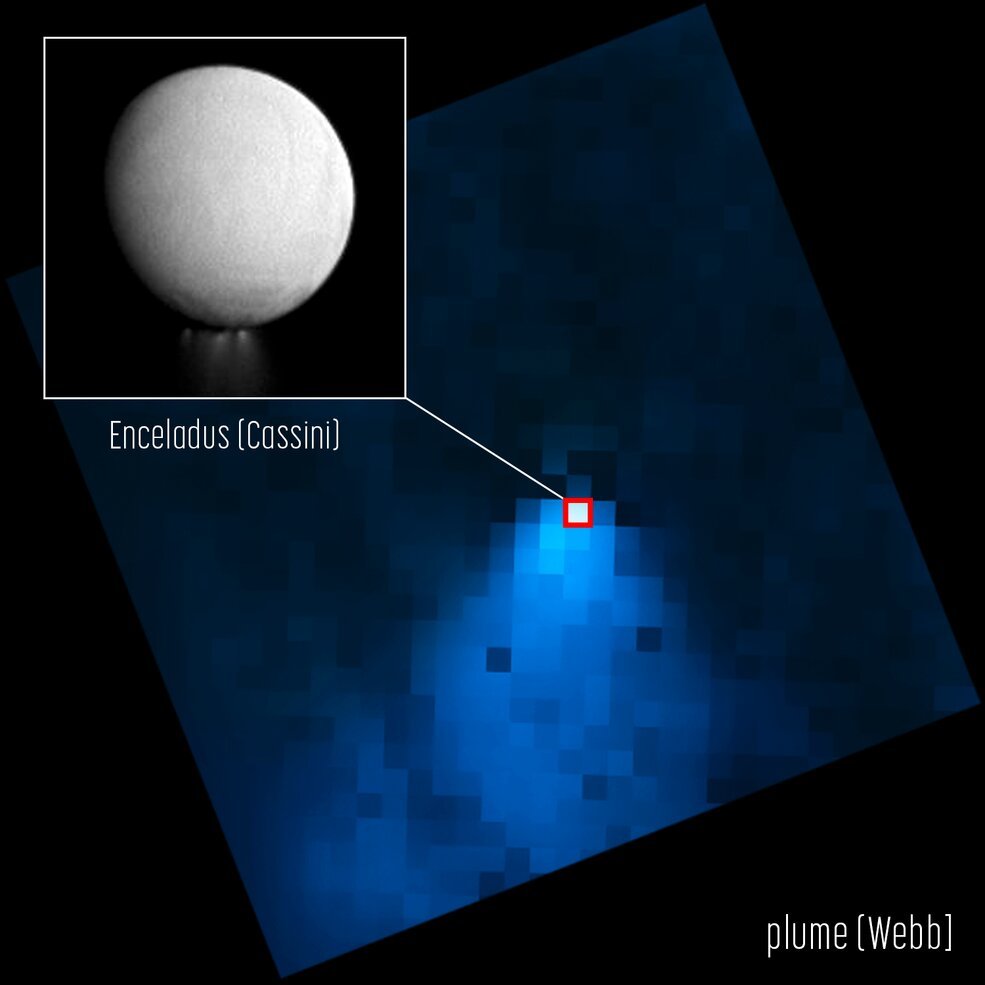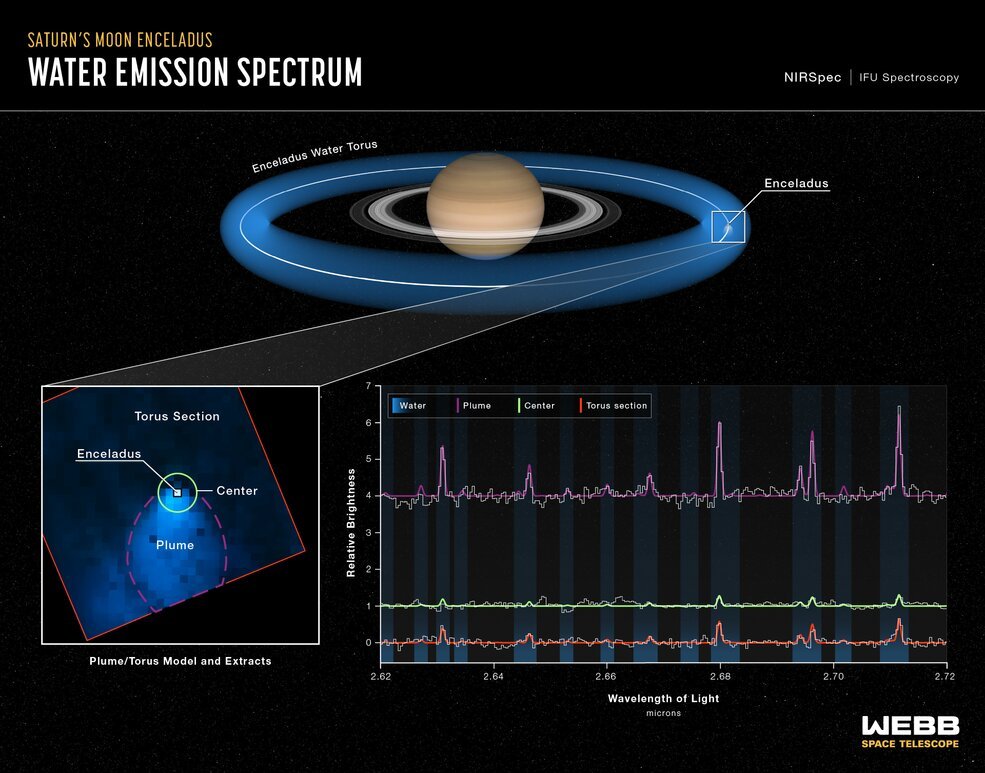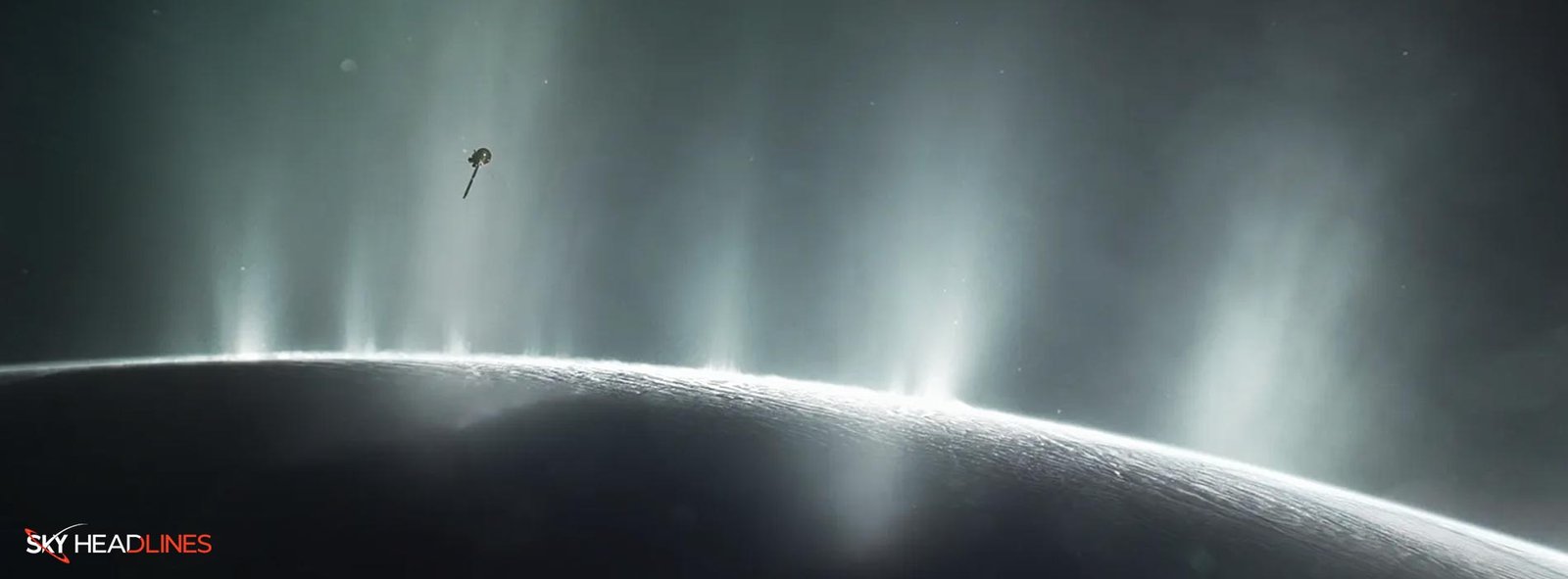You will be surprised to know that astounding revelations have emerged as researchers, harnessing the remarkable capabilities of NASA’s James Webb Space Telescope, uncovered a captivating phenomenon: a captivating water vapor plume emanating from Saturn’s enchanting moon, Enceladus.
This remarkable plume stretches a staggering distance of over 6,000 miles, equivalent to the approximate span between the vibrant cities of Los Angeles, California, and Buenos Aires, Argentina.
Water Vapor Volcanic Plume
Webb is providing scientists with a first-ever direct view of how this water emission feeds the water supply for the entire Saturnian system and its rings.
In a monumental stride for scientific discovery, never before have we witnessed such a captivating spectacle—a water emission water vapor plume of this magnitude stretching across an expansive distance.
Enceladus, a captivating oceanic world measuring a mere 313 miles in diameter and roughly 4% of Earth’s size, stands as an exceptionally alluring scientific pursuit within our solar system when it comes to the quest for alien life.
A vast pool of salty water sits between the moon’s rocky core and frozen outer surface. Informally known as “tiger stripes,” geyser-like volcanoes spray jets of ice particles, water vapor, and organic compounds out of the moon’s surface.
Observatories had previously measured moon jets hundreds of kilometers away, but Webb’s extraordinary sensitivity exposes a new story.

Credits: NASA, ESA, CSA, STScI, and G. Villanueva (NASA’s Goddard Space Flight Center). Image Processing: A. Pagan (STScI).
A lead author Geronimo Villanueva of NASA’s Goddard Space Flight Center in Greenbelt, Maryland. “
“When I was looking at the data, at first, I was thinking I had to be wrong. It was just so shocking to detect a water plume more than 20 times the size of the moon,”
He also said that,
“The water vapor plume extends far beyond its release region at the southern pole.”
What are the Plumes on Europa?
New research suggests that the potential plumes observed on Jupiter’s moon Europa, which may consist of water vapor venting into space, could originate from within the moon’s icy crust.
Scientists have been theorizing about the source of these intriguing plumes, and this recent study introduces a novel possibility.
Instead of being sourced from beneath the crust or from an underground ocean, the plumes could arise from the water present within Europa’s icy crust itself.
This discovery adds a new dimension to our understanding of the moon’s geology and the mechanisms that drive these mysterious eruptions into space.
The researchers were interested in more than just the plume’s length. It is also very astonishing how quickly the water vapor is erupting—about 79 gallons per second.
At this pace, we’d have an Olympic-sized swimming pool filled in no time. On our beloved Earth, achieving the same feat with a garden hose would take over two weeks.
Are water plumes spraying from Europa NASA’s Europa Clipper is on the case?
Scientists caution that detecting water vapor plumes on Europa, Jupiter’s moon, will be challenging, even with close proximity. The world was captivated in 2005 when images revealed a spectacular watery plume erupting from the surface of Enceladus, Saturn’s moon.
Throughout its decade-long exploration of the Saturnian system, the Cassini orbiter captured the first images of Enceladus’s plumes and even flew through them to collect samples of their constituent materials.
While Cassini’s position within the Saturnian system gave it invaluable insights into this far-off moon, Webb’s singular view from the Sun-Earth Lagrange Point 2 and the astounding sensitivity of its Integral Field Unit aboard the NIRSpec (Near-Infrared Spectrograph) Instrument is providing new context.
Villanueva said,
“The orbit of Enceladus around Saturn is relatively quick, just 33 hours. As it whips around Saturn, the moon and its jets are basically spitting off water, leaving a halo, almost like a donut, in its wake,”
He also said that,
“In the Webb Observations, not only was the plume huge, but there was just water absolutely everywhere.”
Now, let’s have a look on the Saturn ring, and see if it has any water vapor, and the reasons behind its existing.
Water Vapor Plume on Saturn’s Ring:
The dense “E-ring,” Saturn’s outermost and broadest ring, is present with the fuzzy torus of water that was observed to be “everywhere.”
The Webb observations clearly show how the torus is fueled by the moon’s water vapor plumes. According to an analysis of the Webb data, only around 30% of the water in this torus escapes, supplying the remaining 70% of the water in the Saturnian system.
Webb will be the main observatory for the ocean moon Enceladus in the coming years, what causses water vapors plume and findings from Webb.
It will help guide future solar system satellite missions that will try to investigate the depth of the underlying ocean, the thickness of the ice crust, and other things.

“Right now, Webb provides a unique way to directly measure how water evolves, and caused water vapor plume and changes over time across Enceladus’ immense plume, and as we see here, we will even make new discoveries and learn more about the composition of the underlying ocean,” added co-author Stefanie Milam at NASA Goddard.
“Because of Webb’s wavelength coverage and sensitivity, and what we’ve learned from previous missions, we have an entire new window of opportunity in front of us.”
Guaranteed Time Observation (GTO) program 1250 was used to conclude Webb’s observations of Enceladus.
This program’s first objective is to showcase Webb’s expertise in a certain scientific field and lay the groundwork for further research.
What the Research of Water Vapor Plume Actually Depicts?
Let’s conclude the above mentioned research by the quote of Heidi Hammel. He is an Association of Universities for Research in Astronomy, Webb interdisciplinary scientist and leader of the GTO program.
“This program was essentially a proof of concept after many years of developing the observatory, and it’s just thrilling that all this science has already come out of quite a short amount of observation time,”





